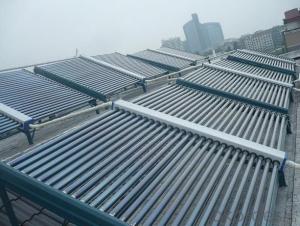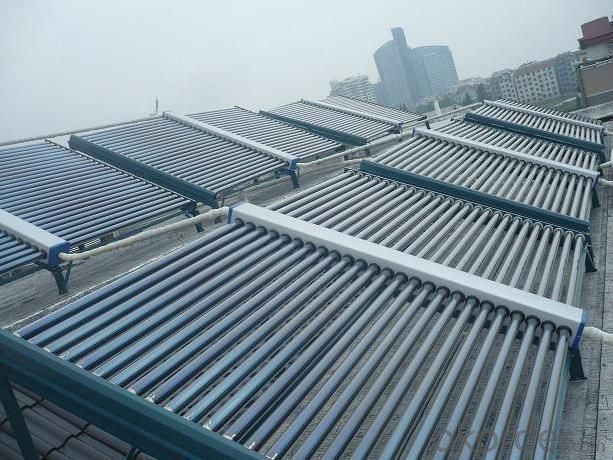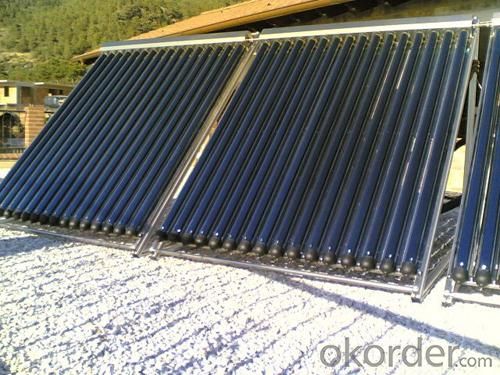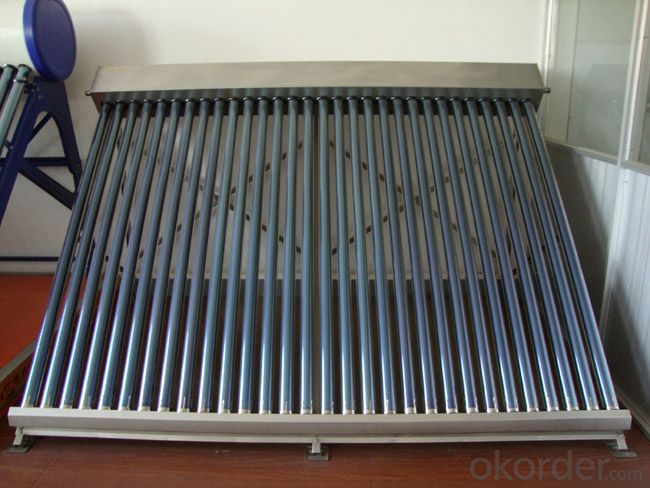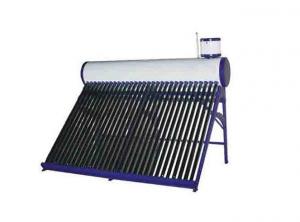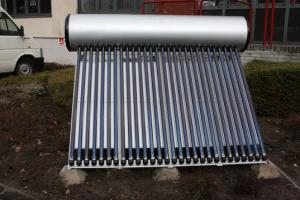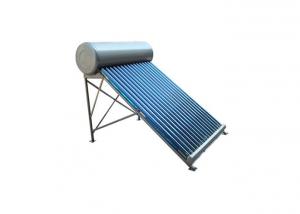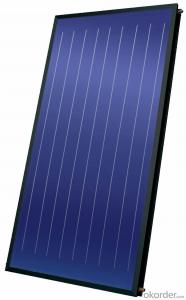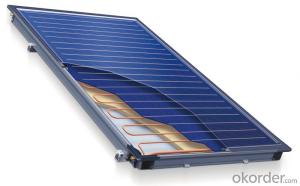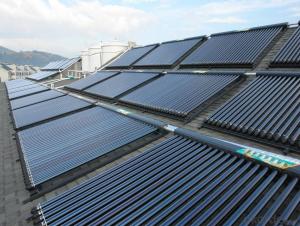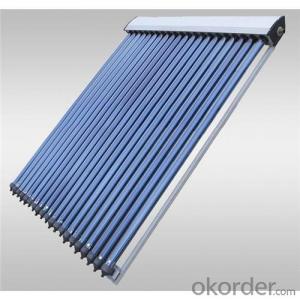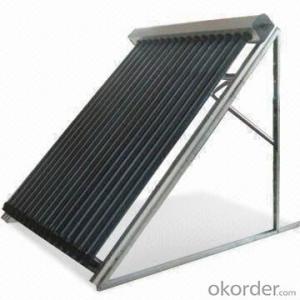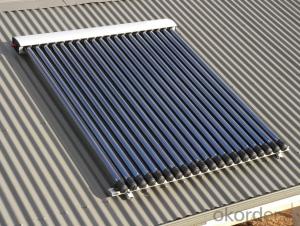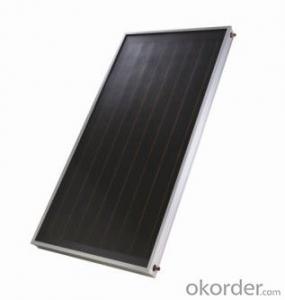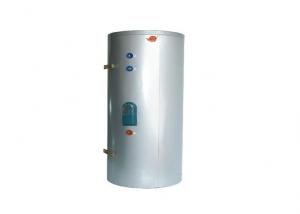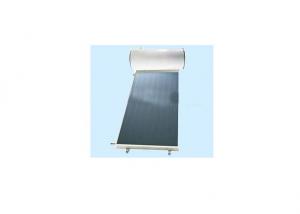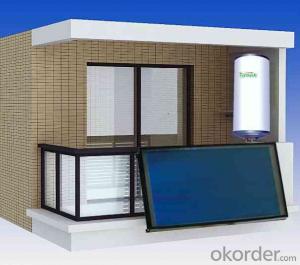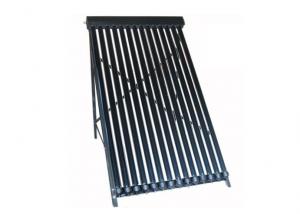12 Tubes Concentrating Solar Collectors En12975
- Loading Port:
- China main port
- Payment Terms:
- TT OR LC
- Min Order Qty:
- 5 set
- Supply Capability:
- 10000 set/month
OKorder Service Pledge
OKorder Financial Service
You Might Also Like
Specification
manifold (inner) | red copper |
manifold (exterior) | aluminum alloy |
glass tube dimensions | 58mm * 1800mm |
daily efficiency | ≥55% |
heat preservation | 72 hours |
hail resistance | 25mm |
max pressure | 7 bar |
coating of vacuum tube | ALN/AIN-SS/CU |
heat pipe | anti-freezing > -35 degree |
certificate | Solar Keymark, EN12975,SRCC |
Serious Product
Models | L*W*H mm | Vacuum tube | Power output | Efficiency | Header mm | Frame | container loading 20FT/40HQ sets | Gross Weight kg |
SHC-8 | 1917*910*133 | 58*1800*8pcs | 939W | 0.668 | Φ35/1.0 | AL alloy | 185/445 | 27 |
SHC-10 | 1917*1130*133 | 58*1800*10pcs | 1189W | 159/385 | 33 | |||
SHC-12 | 1917*1350*133 | 58*1800*12pcs | 1440W | 149/358 | 40 | |||
SHC-15 | 1917*1680*133 | 58*1800*15pcs | 1815W | 120/290 | 49 | |||
SHC-18 | 1917*2010*133 | 58*1800*18pcs | 2191W | 100/242 | 59 | |||
SHC-20 | 1917*2230*133 | 58*1800*20pcs | 2442W | 87/210 | 66 | |||
SHC-22 | 1917*2450*133 | 58*1800*22pcs | 2692W | 83/202 | 72 | |||
SHC-24 | 1917*2670*133 | 58*1800*24pcs | 2943W | 77/188 | 79 |
Packaging & Delivery
Packaging Details: | Exporting Carton with big foaming protection |
Delivery Detail: | In 10-15 days |
Loading Quantity
Model | Tube | Tube Q.T.Y | Loading Q.T.Y/40HQ |
GSC15 | 58*1800mm | 15pcs | 315sets |
GSC18 | 58*1800mm | 18pcs | 265sets |
GSC20 | 58*1800mm | 20pcs | 248sets |
GSC22 | 58*1800mm | 22pcs | 225sets |
GSC25 | 58*1800mm | 25pcs | 200sets |
GSC30 | 58*1800mm | 30pcs | 168sets |
Details of solar collector:
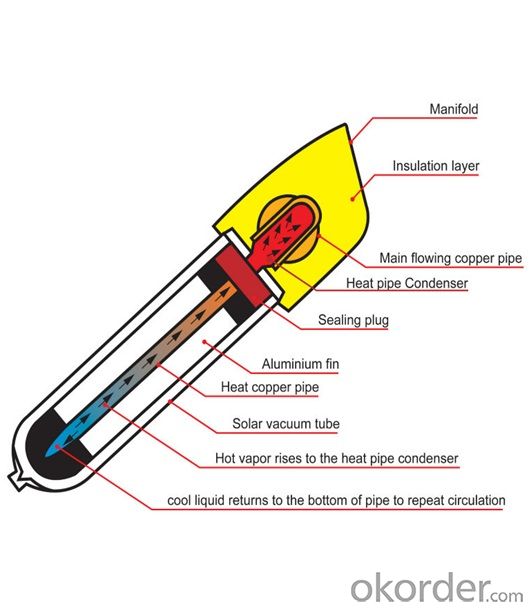
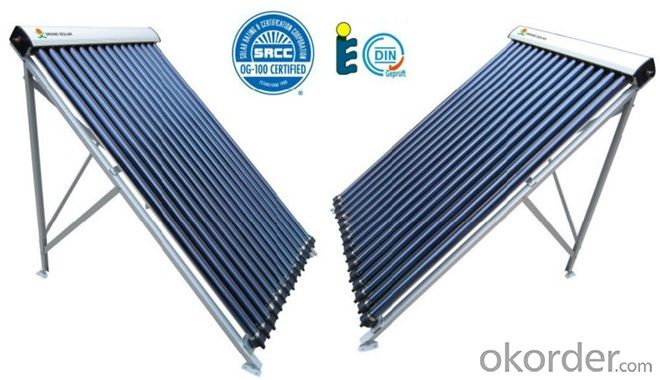

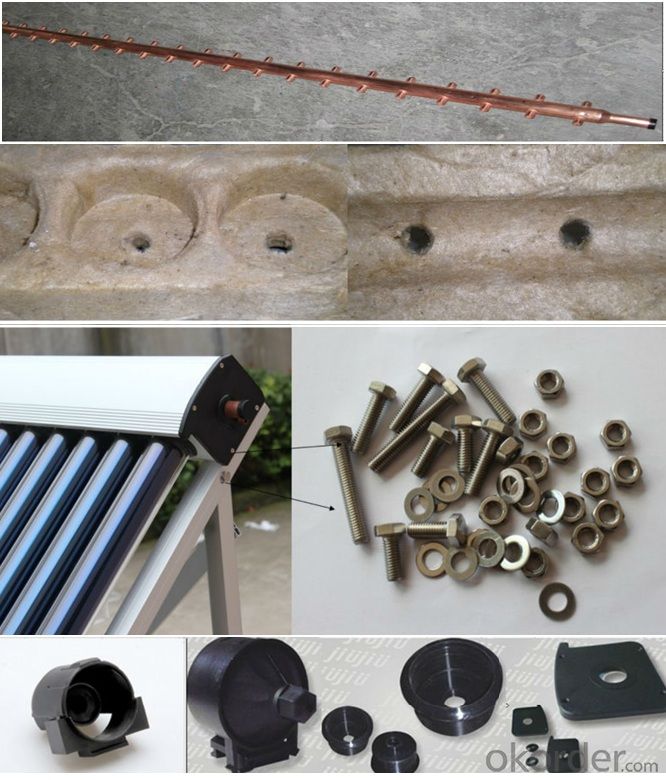
- Q: How do solar collectors affect the environment?
- Solar collectors have a positive impact on the environment as they produce clean and renewable energy without emitting greenhouse gases or other pollutants. They help reduce our dependence on fossil fuels, mitigate climate change, and improve air quality. Additionally, solar collectors occupy minimal space, allowing for land conservation and biodiversity preservation.
- Q: Can solar collectors be used for heating train stations and public transportation terminals?
- Solar thermal collectors, also referred to as solar collectors, have the ability to heat train stations and public transportation terminals. These collectors absorb sunlight and convert it into heat energy. This heat can then serve various purposes, including space heating. Train stations and transportation terminals are typically substantial structures with high heating requirements. The installation of solar collectors on the roof or nearby areas enables the utilization of solar energy to warm these facilities. There exist diverse types of solar collectors suitable for this purpose, such as flat-plate collectors and evacuated tube collectors. These collectors consist of tubes or panels that contain a heat transfer fluid. Sunlight heating the collectors causes the fluid to warm up, which is subsequently circulated through a heat exchanger. The heat is then transferred to the building's heating system. Employing solar collectors for heating train stations and public transportation terminals presents numerous benefits. Firstly, it is an environmentally friendly and sustainable energy source that reduces reliance on fossil fuels and minimizes greenhouse gas emissions. Secondly, it aids in cost reduction, as solar energy is abundant and free. Additionally, solar collectors necessitate minimal maintenance and have a long lifespan, making them a cost-effective long-term heating solution. However, specific factors must be taken into consideration when utilizing solar collectors for large facilities' heating purposes. The size and quantity of collectors must be carefully calculated to match the heating requirements of the train station or terminal. Furthermore, the positioning and orientation of the collectors should be optimized to maximize exposure to sunlight and energy absorption. In conclusion, solar collectors are indeed a viable option for heating train stations and public transportation terminals. They provide a sustainable and cost-effective heating solution, contributing to the reduction of environmental impact and energy expenses. With appropriate design and installation, solar collectors can effectively satisfy the heating needs of these facilities.
- Q: Can solar collectors be used for heating roadways?
- Yes, solar collectors can be used for heating roadways.
- Q: Are solar collectors compatible with existing plumbing systems?
- Yes, solar collectors are compatible with existing plumbing systems. They can be easily integrated into the existing plumbing infrastructure to heat water or supplement the existing hot water supply.
- Q: Are solar collectors suitable for military applications?
- Yes, solar collectors are suitable for military applications. They provide a reliable and renewable source of energy, reducing the dependency on traditional fuel sources and enhancing energy security in remote or deployed military operations. Solar collectors can power various equipment, including communication systems, surveillance tools, lighting, and charging stations, making them a sustainable and cost-effective solution for the military. Additionally, their portability and scalability make them adaptable to different operational environments, further supporting their suitability for military applications.
- Q: How do solar collectors compare to traditional fossil fuel-based heating systems in terms of emissions?
- Solar collectors are far superior to traditional fossil fuel-based heating systems when it comes to emissions. Fossil fuel-based heating systems, such as those that rely on burning coal, oil, or natural gas, emit large amounts of greenhouse gases, primarily carbon dioxide (CO2), which contribute to global warming and climate change. On the other hand, solar collectors generate heat by harnessing the sun's energy, which produces no direct emissions or pollution. By using solar collectors for heating, we can significantly reduce our carbon footprint and mitigate the negative impact on the environment. Solar energy is a renewable and clean source of power, ensuring that no harmful pollutants are released into the atmosphere during its generation. This makes solar collectors a crucial component in transitioning to a more sustainable and eco-friendly future. Furthermore, solar collectors do not require any ongoing fuel supply, as they solely rely on the abundant and free energy from the sun. In contrast, fossil fuel-based systems are dependent on the extraction, transportation, and burning of fossil fuels, which not only depletes finite resources but also contributes to air pollution and environmental degradation. In summary, solar collectors outshine traditional fossil fuel-based heating systems in terms of emissions. They offer a sustainable and environmentally friendly alternative, helping to combat climate change, reduce air pollution, and preserve our planet for future generations.
- Q: What is the average cost of a solar collector system?
- The average cost of a solar collector system can vary depending on various factors such as the size of the system, type of collectors used, installation costs, and location. However, on average, a solar collector system can cost anywhere from $10,000 to $30,000.
- Q: How long does it take to install a solar collector?
- The installation time for a solar collector can vary depending on several factors, including the size and complexity of the system, the location, and the expertise of the installer. However, on average, the installation process can take anywhere from a few days to a couple of weeks.
- Q: Can solar collectors be used for heating residential complexes?
- Yes, solar collectors can be used for heating residential complexes. Solar collectors, such as solar thermal panels or solar water heaters, can efficiently capture and convert sunlight into heat energy. This heat energy can then be used for various heating purposes, including space heating and water heating in residential complexes. By harnessing the power of the sun, solar collectors offer an environmentally friendly and cost-effective solution for heating residential buildings.
- Q: Can solar collectors be used for heating theaters and concert halls?
- Yes, solar collectors can be used for heating theaters and concert halls. Solar thermal systems can efficiently capture sunlight and convert it into heat energy, which can then be used to provide heating for indoor spaces. By utilizing solar collectors, theaters and concert halls can reduce their reliance on traditional heating systems and lower their energy costs while also contributing to a more sustainable and environmentally-friendly approach to heating.
Send your message to us
12 Tubes Concentrating Solar Collectors En12975
- Loading Port:
- China main port
- Payment Terms:
- TT OR LC
- Min Order Qty:
- 5 set
- Supply Capability:
- 10000 set/month
OKorder Service Pledge
OKorder Financial Service
Similar products
Hot products
Hot Searches
Related keywords
